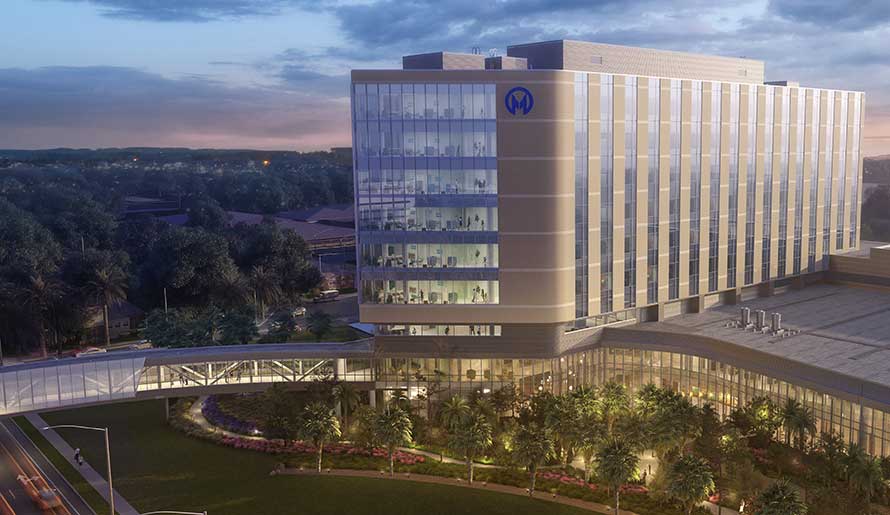Leukemia Diagnosis
Leukemia is a relatively common cancer that originates in the blood-forming (lymphoid) cells in the bone marrow. The cancer begins when healthy cells undergo harmful changes that cause them to grow and divide uncontrollably. Excess abnormal cells then build up and crowd out healthy cells. Symptoms can include enlarged lymph nodes, easy bruising and bleeding, frequent infections and fatigue.
Leukemia is classified as acute or chronic and by the type of white blood cell affected (lymphocytic or myeloid). The types include acute lymphocytic leukemia (ALL), which is common in children, and acute myeloid leukemia (AML) and chronic lymphocytic leukemia (CLL), which are more prevalent in adults.


Rated High Performing in Leukemia, Lymphoma & Myeloma
Schedule an AppointmentHow to prepare for diagnostic testing for leukemia
If leukemia is suspected based on the symptoms, the physician will typically order diagnostic testing, which may include blood work, biopsy and/or imaging. To help the patient prepare, the physician will explain each test and provide detailed pre-test instructions, which may include fasting. The patient should provide the physician with a complete list of their current medications—including prescription drugs, over-the-counter remedies, vitamins and supplements—because some medications may need to be adjusted or temporarily stopped before testing.
In general, many patients find it helpful to drink plenty of water to ensure proper hydration and get plenty of rest before a diagnostic test for leukemia. Additionally, because some tests such as bone marrow biopsy may involve sedation, the patient will need to arrange for transportation and post-test support. Understanding the diagnostic process and preparing both physically and mentally can help ensure a streamlined experience and accurate results.
What laboratory tests are used for diagnosing leukemia?
The diagnostic process for leukemia usually begins with a physical examination followed by blood and bone marrow testing, such as:
Complete blood count (CBC)
Often the first lab test performed in the diagnostic process for leukemia, a CBC can provide valuable information about blood cells. An abnormality in a blood cell count, such as low red blood cells (anemia), low platelets (thrombocytopenia) or high white blood cells (leukocytosis), may indicate leukemia.
Peripheral blood smear (PBS)
Unlike a CBC, which uses a machine to analyze a blood sample, a PBS involves a microscopic analysis of the blood cells by a pathologist. A physician may order a PBS to follow up on a CBC that revealed an abnormal blood cell count. The result may help the physician determine the reason for the abnormality.


Top 1% of Cancer Hospitals
Schedule an AppointmentImmunophenotyping
Immunophenotyping is a laboratory technique used to analyze the types and characteristics of cells by identifying specific markers on their surface. In the context of diagnosing leukemia, immunophenotyping can help a physician determine the specific subtype of leukemia by detecting the unique combination of surface antigens expressed by the leukemia cells. This information can be used to guide treatment, as different subtypes of leukemia respond differently to various therapies.
Flow cytometry
Flow cytometry involves staining blood cells with a fluorescent dye and then passing the cells through a laser beam. The dye will cause the cells to emit light, which will be measured by a special detector. This sensitive technology can help a physician determine the cell types present in a blood sample and identify specific protein markers on their surface. Based on the markers, the physician can differentiate between healthy and cancerous cells and, if leukemia is diagnosed, classify its type.
Genetic testing
After small tissue and fluid samples are collected through blood or bone marrow testing, the samples will be microscopically examined by a cytogeneticist. Known as cytogenetic analysis, this process can detect chromosome changes and, in some cases, identify the affected genes.
Molecular testing
A type of precision medicine, molecular profiling seeks to identify the specific deoxyribonucleic acid (DNA), ribonucleic acid (RNA) or protein molecule associated with leukemia. A small sample of blood or bone marrow will be sent to a laboratory, where it will undergo various molecular profiling tests to help the physician identify unique biomarkers that correspond to the leukemia. This vital information can inform treatment decisions and identify patients who may benefit from targeted therapies.
Some methods currently used for molecular profiling include:
- Immunohistochemistry (IHC)
- Fluorescence in situ hybridization (FISH)
- Next-generation sequencing (NGS)
- Quantitative polymerase chain reaction (qPCR)
What procedures are used for diagnosing leukemia?
In addition to lab tests, several procedures may be used to diagnose leukemia, including:
Bone marrow biopsy
The gold standard in diagnosing leukemia is bone marrow biopsy. To perform this test, a physician will insert a long, thin needle into the hip bone or another large bone and withdraw a small sample of bone marrow. The sample will be sent to a lab for microscopic examination by a pathologist, who can identify abnormalities in the number, size and appearance of the cells.
Often performed if another diagnostic test, such as CBC or flow cytometry, suggests leukemia, bone marrow biopsy can help the physician confirm the diagnosis, determine the type and subtype of leukemia and assess the extent of the cancer. The results can be used to guide treatment decisions and determine the prognosis.
Spinal tap
Although leukemia usually begins in the bone marrow, it can sometimes spread to the central nervous system (CNS), which includes the brain and spinal cord. Also known as a lumbar puncture, a spinal tap may be used to diagnose leukemia by examining a sample of cerebrospinal fluid (CSF) for the presence of cancer cells.
After injecting a local anesthetic into the lower back, a physician will insert a thin needle between the vertebrae and into the spinal canal. The physician will measure the CSF pressure, withdraw a small sample of fluid and then remeasure the pressure. After removing the needle, the physician will cover the puncture site with a bandage and send the CSF sample to a lab for microscopic examination by a pathologist.
During a spinal tap, the physician may also inject a small dose of chemotherapy into the spinal fluid to destroy any leukemia cells that may be present.
What imaging tests are used to diagnose leukemia?
While imaging is not used to directly diagnose leukemia, a physician may order imaging tests to determine whether leukemia cells have spread and check for complications, such as lymph node enlargement and organ involvement. Some options include:
- Chest X-ray
- Computed tomography (CT) scan
- Magnetic resonance imaging (MRI) scan
- Positron emission tomography (PET) scan
- Ultrasound scan
Frequently asked questions (FAQs) diagnosis leukemia
The following FAQs-related articles provide additional information about the diagnostic process for leukemia:
The next steps after a leukemia diagnosis
After receiving a leukemia diagnosis, the patient will want to take steps to learn about their condition and find the best possible care. This may include:
- Consulting with a hematologist/oncologist – A specialist can fully explain the diagnosis, including the type and stage of leukemia, and answer any questions.
- Undergoing further testing – Additional tests, such as bone marrow biopsy, genetic testing and imaging studies, may be needed to help the physician evaluate the specific characteristics and extent of the leukemia and plan treatment.
- Exploring treatment options – Based on the diagnosis and test results, the physician will suggest a personalized treatment plan, which may include chemotherapy, radiation therapy, CAR T-cell therapy, immunotherapy or bone marrow transplantation.
- Seeking support – The patient may want to take advantage of supportive care services, such as counseling, education and support groups, which may help them cope with the emotional and practical aspects of the diagnosis.
- Planning for assistance during treatment – The physician will discuss any lifestyle changes that might be necessary during leukemia treatment so the patient can make appropriate arrangements for family, work and other responsibilities.
- Seeking a second opinion – The patient may want to receive a second opinion to confirm the diagnosis and treatment plan, which can provide additional reassurance and potentially new treatment options.
These steps can ensure a comprehensive approach to managing leukemia, helping the patient and their family navigate the treatment process smoothly and effectively.
Benefit from world-class care at Moffitt Cancer Center
Moffitt is recognized as a Comprehensive Cancer Center by the National Cancer Institute, a designation that acknowledges our commitment to continually advancing cancer care through groundbreaking research and clinical trials. At Moffitt, we understand that each patient and diagnosis is different, and the leukemia team in our Malignant Hematology Program works collaboratively with the team in our Bone and Marrow Transplant and Cellular Immunotherapy Program to determine the optimal treatment approach in each case.
If you would like to learn more about the diagnostic process for leukemia, you can request an appointment with a specialist in Moffitt’s Malignant Hematology Program by calling 1-888-663-3488 or submitting a new patient registration form online.
Inspiring Stories
Diagnosis



